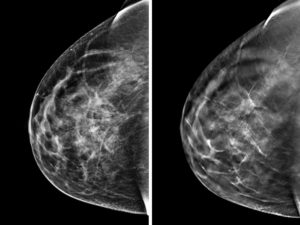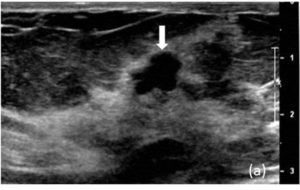Breast Imaging
It is important to know the differences between the various types of breast imaging. While all breast screening tools have one goal in mind (identify breast cancer), they go about looking for cancer in very different ways. No test is a substitute for another – but the do compliment one another greatly! As always, there are individuals who only choose one type of breast screening tool. As long as you are aware and educated on the differences, you have every right to make that decision. Today, you must be your own best advocate and be aware of the options you have! We hope you find this helpful!
Mammogram

How it works:
Mammograms compress the breast tissue and pass radiation through the breast to identify abnormal areas.
Type of Test:
Anatomical – looks for structure
Radiation use?
Yes
Size of lump at detection
Typically 0.5 to 1.5 cm
Sensitivity of test:
Varies due to age/density of breasts. Ages 50+ have 80% sensitivity; less than 60% sensitive in women under age 50. (Approx 20-40+% of BC undetected).
Painful?
Most women say yes. There may be up to 50 lbs of compression on the breast tissue during the procedure. Bruising and soreness may occur.
Sees calcifications?
Yes – a mammogram does find calcifications
Monitors breast health?
No – mammograms only look for signs of breast cancer
Are breast implants problematic?
Some breast implants can affect mammogram interpretation based on the location of the implant. There is also a small risk of rupture during compression.
Can it diagnose breast cancer?
No! Mammography is a screening tool – only a biopsy can diagnose breast cancer!
Thermogram

How it works:
Thermograms collect and map the infrared heat that is coming off your body to identify areas that have increased vascular activity – a result of angiogenesis.
Type of Test:
Physiological – looks at function/blood flow
Radiation use?
No
Size of lump at detection
May be seen prior to lump formation if early baseline established.
Sensitivity of test:
Averages 90% sensitivity in all age groups. (Approximately 10% of BC undetected)
Painful?
No – the process is as easy and painless as having your picture taken. Hands will rest on top of the head for up to 1 minute, which may be difficult for some.
Sees calcifications?
Thermograms do not see structures, but inflammation may be present at the site of calcifications
Monitors breast health?
Yes! Thermography looks at your overall breast health, such as lymphatic congestion/drainage, inflammation of tissues, severe hormonal imbalances, and others! It is a great tool to use to be proactive about your breast health.
Are breast implants problematic?
No! Breast implants are perfectly safe to use with thermography and does not interfere with results.
Can it diagnose breast cancer?
No! Thermography is a screening tool – only a biopsy can diagnose breast cancer!
Ultrasound

How it works:
Ultrasounds use sound waves to evaluate breast lumps. As the sound waves bounce off the tissue an echo is collected to produce the images.
Type of Test:
Anatomical – looks for structure
Radiation use?
No
Size of lump at detection
Rarely used as first line screening tool
Sensitivity of test:
Averages 83% sensitivity in all age groups. (Approximately 17% of BC missed)
Painful?
Ultrasounds are generally painless, unless the lump being evaluated is tender to the touch.
Sees calcifications?
No – ultrasounds do not see calcifications
Monitors breast health?
No – ultrasounds only look for signs of breast cancer and cystic activity
Are breast implants problematic?
No – there should not be any concerns using ultrasound with breast implants.
Can it diagnose breast cancer?
No! Ultrasound is a screening tool – only a biopsy can diagnose breast cancer!